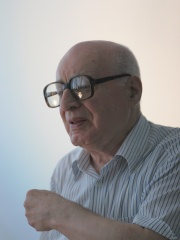
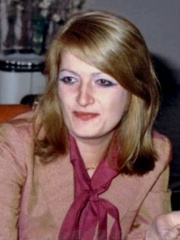
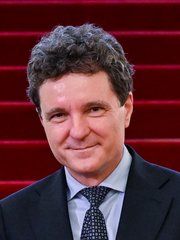
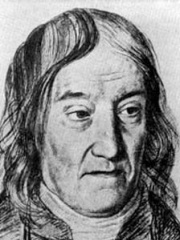
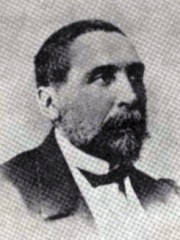
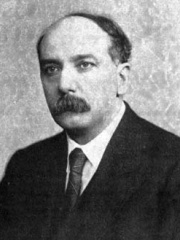
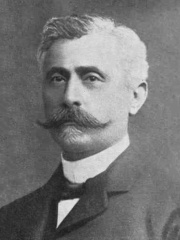

The Most Famous
MATHEMATICIANS from Romania
This page contains a list of the greatest Romanian Mathematicians. The pantheon dataset contains 1,004 Mathematicians, 10 of which were born in Romania. This makes Romania the birth place of the 23rd most number of Mathematicians behind Greece, and Canada.
Top 10
The following people are considered by Pantheon to be the top 10 most legendary Romanian Mathematicians of all time. This list of famous Romanian Mathematicians is sorted by HPI (Historical Popularity Index), a metric that aggregates information on a biography's online popularity. Visit the rankings page to view the entire list of Romanian Mathematicians.

1. János Bolyai (1802 - 1860)
With an HPI of 73.80, János Bolyai is the most famous Romanian Mathematician. His biography has been translated into 49 different languages on wikipedia.
János Bolyai (; Hungarian: [ˈjaːnoʃ ˈboːjɒi]; 15 December 1802 – 27 January 1860) or Johann Bolyai, was a Hungarian mathematician who developed absolute geometry—a geometry that includes both Euclidean geometry and hyperbolic geometry. The discovery of a consistent alternative geometry that might correspond to the structure of the universe helped to free mathematicians to study abstract concepts irrespective of any possible connection with the physical world.

2. Zoia Ceaușescu (1949 - 2006)
With an HPI of 68.26, Zoia Ceaușescu is the 2nd most famous Romanian Mathematician. Her biography has been translated into 26 different languages.
Zoia Ceaușescu (Romanian pronunciation: [ˈzoja tʃe̯a.uˈʃesku]; 28 February 1949 – 20 November 2006) was a Romanian mathematician, the daughter of Communist leader Nicolae Ceaușescu and his wife, Elena and sister of Nicu Ceaușescu and Valentin Ceaușescu. She was also known as Tovarășa Zoia (comrade Zoia).

3. Nicușor Dan (b. 1969)
With an HPI of 67.75, Nicușor Dan is the 3rd most famous Romanian Mathematician. His biography has been translated into 51 different languages.
Nicușor Dan (Romanian: [nikuˈʃor daniˈel ˈdan]; born 20 December 1969) is a Romanian mathematician and politician serving as the sixth president of Romania since 2025. He previously served as the mayor of Bucharest from 2020 to 2025 and as a member of the Chamber of Deputies from 2016 to 2020. Born in Făgăraș, Brașov County, Dan earned international acclaim in his youth as a mathematician, securing gold medals and perfect scores at the 1987 and 1988 International Mathematical Olympiads. He began studying mathematics at the University of Bucharest and then moved to France, where he obtained a master's degree from École normale supérieure and a PhD from Paris 13 University. After returning to Romania, Dan founded Școala Normală Superioară București, an institution aimed at guiding the most talented Romanian students towards scientific research, and became a civic activist. In 2015, Dan founded the Save Bucharest Union (USB), focusing on anti-corruption and heritage preservation. One year later, he co-founded the Save Romania Union (USR), but resigned from the party in 2017 over its progressive shift, preferring a more centrist approach. Dan served in the Chamber of Deputies from 2016, before being elected Bucharest's second independent mayor in 2020 and winning re-election in 2024. As mayor, he focused on public infrastructure and transparency, although he received criticism over construction delays. Dan ran as an independent for the 2025 presidential election and received 21% of the vote in the first round, placing second. He faced Alliance for the Union of Romanians (AUR) founder George Simion in the runoff, defeating him with 53.6% of the vote. Dan ran on a pro-Western platform, which contrasted with his opponent's nationalist and Eurosceptic stance.

4. Farkas Bolyai (1775 - 1856)
With an HPI of 64.27, Farkas Bolyai is the 4th most famous Romanian Mathematician. His biography has been translated into 27 different languages.
Farkas Bolyai (Hungarian: [ˈfɒrkɒʃ ˈboːjɒi]; 9 February 1775 – 20 November 1856; also known as Wolfgang Bolyai in Germany) was a Hungarian mathematician, mainly known for his work in geometry.

5. Abraham Wald (1902 - 1950)
With an HPI of 64.20, Abraham Wald is the 5th most famous Romanian Mathematician. His biography has been translated into 31 different languages.
Abraham Wald (; German: [valt]; Hungarian: Wald Ábrahám, Yiddish: אברהם וואַלד; (1902-10-31)31 October 1902 – (1950-12-13)13 December 1950) was a Hungarian and American mathematician and statistician who contributed to decision theory, geometry and econometrics, and founded the field of sequential analysis. One of his well-known statistical works was written during World War II on how to minimize the damage to bomber aircraft and took into account the survivorship bias in his calculations. He spent his research career at Columbia University. He was the grandson of Rabbi Moshe Shmuel Glasner.

6. Ion Ghica (1816 - 1897)
With an HPI of 60.32, Ion Ghica is the 6th most famous Romanian Mathematician. His biography has been translated into 25 different languages.
Ion Ghica (Romanian pronunciation: [iˈon ˈɡika] ; 24 August [O.S. 12 August] 1816 – 19 May [O.S. 7 May] 1897) was a Romanian statesman, mathematician, diplomat, and politician, who served as Prime Minister of Romania five times. He was a full member of the Romanian Academy and its president on several occasions (1876–1882, 1884–1887, 1890–1893, and 1894–1895). He was the older brother and associate of Pantazi Ghica, a prolific writer and politician.

7. Ion Barbu (1895 - 1961)
With an HPI of 56.18, Ion Barbu is the 7th most famous Romanian Mathematician. His biography has been translated into 21 different languages.
Ion Barbu (Romanian pronunciation: [iˈon ˈbarbu], pen name of Dan Barbilian; 18 March 1895 –11 August 1961) was a Romanian mathematician and poet. His name is associated with the Mathematics Subject Classification number 51C05, which is a major posthumous recognition reserved only to pioneers of investigations in an area of mathematical inquiry. As a poet, he is known for his volume Joc secund ("Mirrored Play"), in which he sought to fulfill his vision of a poetry which adhered to the same virtues that he found in mathematics.

8. Spiru Haret (1851 - 1912)
With an HPI of 55.71, Spiru Haret is the 8th most famous Romanian Mathematician. His biography has been translated into 16 different languages.
Spiru C. Haret (Romanian pronunciation: [ˈspiru haˈret]; 15 February 1851 – 17 December 1912) was a Romanian mathematician, astronomer, and politician. He made a fundamental contribution to the n-body problem in celestial mechanics by proving that using a third degree approximation for the disturbing forces implies instability of the major axes of the orbits, and by introducing the concept of secular perturbations in relation to this. As a politician, during his three terms as Minister of Education, Haret ran deep reforms, building the modern Romanian education system. He was made a full member of the Romanian Academy in 1892. He also founded the Bucharest Astronomical Observatory, appointing Nicolae Coculescu as its first director. The crater Haret on the Moon is named after him.

9. George Lusztig (b. 1946)
With an HPI of 54.87, George Lusztig is the 9th most famous Romanian Mathematician. His biography has been translated into 20 different languages.
George Lusztig (born Gheorghe Lusztig; May 20, 1946) is a Romanian-born American mathematician and Abdun Nur Professor at the Massachusetts Institute of Technology (MIT). He was a Norbert Wiener Professor in the Department of Mathematics from 1999 to 2009.
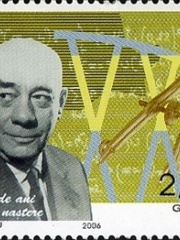
10. Grigore Moisil (1906 - 1973)
With an HPI of 54.13, Grigore Moisil is the 10th most famous Romanian Mathematician. His biography has been translated into 18 different languages.
Grigore Constantin Moisil (Romanian: [ɡriˈɡore mo.iˈsil]; 10 January 1906 – 21 May 1973) was a Romanian mathematician, computer pioneer, and titular member of the Romanian Academy. His research was mainly in the fields of mathematical logic (Łukasiewicz–Moisil algebra), algebraic logic, MV-algebra, and differential equations. He is viewed as the father of computer science in Romania. Moisil was also a member of the Academy of Sciences of Bologna and of the International Institute of Philosophy. In 1996, the IEEE Computer Society awarded him posthumously the Computer Pioneer Award.
People
Pantheon has 11 people classified as Romanian mathematicians born between 1775 and 1969. Of these 11, 2 (18.18%) of them are still alive today. The most famous living Romanian mathematicians include Nicușor Dan, and George Lusztig. The most famous deceased Romanian mathematicians include János Bolyai, Zoia Ceaușescu, and Farkas Bolyai. As of April 2024, 1 new Romanian mathematicians have been added to Pantheon including Nicușor Dan.
Living Romanian Mathematicians
Go to all RankingsDeceased Romanian Mathematicians
Go to all RankingsJános Bolyai
1802 - 1860
HPI: 73.80
Zoia Ceaușescu
1949 - 2006
HPI: 68.26
Farkas Bolyai
1775 - 1856
HPI: 64.27
Abraham Wald
1902 - 1950
HPI: 64.20
Ion Ghica
1816 - 1897
HPI: 60.32
Ion Barbu
1895 - 1961
HPI: 56.18
Spiru Haret
1851 - 1912
HPI: 55.71
Grigore Moisil
1906 - 1973
HPI: 54.13
Solomon Marcus
1925 - 2016
HPI: 53.97
Newly Added Romanian Mathematicians (2025)
Go to all RankingsOverlapping Lives
Which Mathematicians were alive at the same time? This visualization shows the lifespans of the 9 most globally memorable Mathematicians since 1700.

